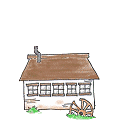posted 3 years ago
Kenneth,
That’s not a bad idea if I were doing this for the first time. Somehow I don’t think my wife would like me keyline plowing the backyard, but as I am approaching this as part of a longer term project, I am not certain that the keyline plow would work, though I like your lateral thinking.
As it is , the backyard is a rough rectangle that runs approximately north-south while sloping west, particularly at the southernmost side. I the past I have tried to tackle the whole backyard only to fail at the whole project, this time I am taking bite-sized pieces, hoping to restore highly degraded parts this year, then move on to other , less-degraded areas next year.
I am also tinkering with a more “Permie” approach to yard improvement. For starters, long-gone are the days of spraying ’cides to make way for grass—a technique that was not only dangerous but also counterproductive. This time around I am deliberately leaving existing vegetation in place—it all appears to be broadleaf weeds anyway. I am going to let those weeds act as a nurse crop and hold the seed in place and shade the ground from beating sunlight that dries out the surface of the ground.
I know how important it is for fine grass seed to stay watered early on, and my conclusion is that is because just after germination, the fine roots dry out easily before drilling themselves into earth looking for a better supply of moisture. Regular, daily watering does keep the grass alive but at a cost—the roots don’t root deeply, at least not for some time. The young grass gets sorta addicted to watering. By using the existing “weeds” I hope to nurse the little seeds along and encourage their roots to grow deep. My grass crop is looking good so far and the surface has stayed moist. Hopefully the roots will grow deep before the clay dries out, but fortunately more rain is in the forecast,
Ultimately I hope to bring the broadleaf weeds under control simply by mowing and that will be a gradual process. Also, I am HOPING that a heat tolerant bluegrass will thicken up the lawn, add more soft, finer grass blades and eventually choke out the weeds. I did use a heat tolerant bluegrass mixed in with fescue for some sections of my front yard and it is looking pretty good. I am hoping to achieve similar results in the back.
And again, as I stated before, I am tackling chunks—going after the worst patches this year and hoping to move on to other sections next year. I did a spring sowing when fall seeding is generally recommended, but I get so little time in fall that I decided to just do it! However, the bluegrass will go in this fall.
So there is my extremely long-winded response. I am totally up to suggestions and I appreciate everything one, even if I can’t use it.
Thoughts and/or comments are always welcome.
Eric
Some places need to be wild






 1
1
































 1
1




 1
1


















 1
1






